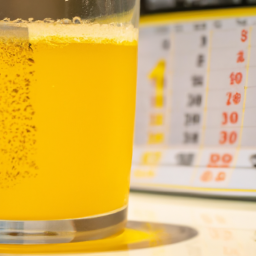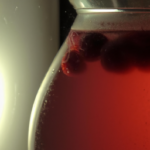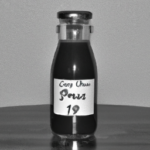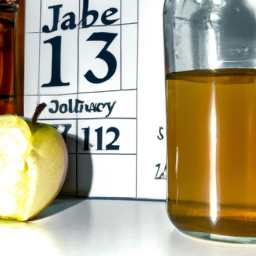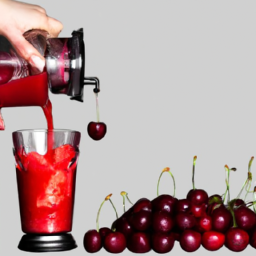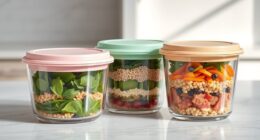As someone who appreciates a well-stocked fridge, I recognize the importance of keeping my drinks and snacks fresh for as long as possible. I often ponder how long juice lasts once it’s been opened. This is a question that many people have, and the answer can vary depending on several factors.
When it comes to the shelf life of juice, there are a number of factors that can influence how long it stays fresh. From the type of juice to the storage conditions, there are many things to consider.
In this article, we’ll take a look at some of the key factors that can impact the shelf life of different types of juice, as well as some general tips for keeping your juice fresh and safe to drink.
So whether you’re a juice connoisseur or simply enjoy the occasional glass, read on to learn more about how to keep your juice fresh and delicious for as long as possible.
Key Takeaways
- Proper storage in airtight containers and refrigeration can extend the shelf life of juice.
- Signs of spoilage include separation, cloudiness, color change, sour/musty smell/taste, and thick/slimy consistency.
- Different types of juice have different shelf lives after opening, ranging from 5 days to 2 weeks.
- Container type is important for storage, with glass being preferred over plastic for long-term storage.
Factors Affecting Juice Shelf Life
Did you know that the shelf life of your juice after opening can be affected by several factors? These factors can be divided into two categories: intrinsic factors and extrinsic factors.
Intrinsic factors refer to the characteristics of the juice itself, such as its pH level, sugar content, and presence of preservatives. Extrinsic factors, on the other hand, refer to the environmental conditions that the juice is subjected to, such as temperature and exposure to air.
Factors affecting juice spoilage include the presence of microorganisms, oxidation, and enzymatic reactions. Microbial growth can occur when juice is exposed to air and allowed to sit at room temperature for an extended period of time. Oxidation can cause the juice to lose its flavor and color, while enzymatic reactions can cause the juice to turn bitter and cloudy.
To extend the shelf life of your juice, it’s important to store it in the refrigerator as soon as possible after opening, and to consume it within a few days. Keeping the juice in an airtight container can also help to slow down microbial growth and oxidation.
Now, let’s take a closer look at how these factors affect the shelf life of orange juice.
Orange Juice
When it comes to orange juice, there are several factors that can affect its shelf life after opening. As someone who enjoys orange juice, I always make sure to keep an eye out for signs of spoilage, such as a sour smell or mold growth.
To ensure that my orange juice stays fresh for as long as possible, I also follow certain tips for proper storage. For example, I refrigerate it and use an airtight container.
Shelf Life After Opening
Once you crack open a bottle or carton of juice, its shelf life starts ticking down. However, there are ways to extend the freshness of your juice to ensure that you can enjoy it for as long as possible. Here are some tips to keep in mind:
- Store your juice in the refrigerator as soon as possible after opening.
- Keep the juice in its original container or transfer it to an airtight container.
- Avoid exposing the juice to air as much as possible.
- Don’t store the juice in the door of the refrigerator, as temperature fluctuations can affect its quality.
- Pay attention to the expiration date on the container, as this will give you a good idea of how long the juice will last.
By following these guidelines, you can help keep your juice tasting fresh for longer. However, it’s important to be aware of the signs of spoilage, which we’ll discuss in the next section.
Signs of Spoilage
Keeping your juice fresh is important, so it’s essential to know the signs of spoilage. Even if you store your juice properly, it can still become contaminated with common pathogens that can pose health risks. Here are some signs to look out for to determine if your juice has gone bad:
| Signs of Spoilage | |
|---|---|
| Appearance | Separation of solids and liquids, cloudiness, or change in color |
| Smell | Sour, musty, or off-putting odor |
| Taste | Sour or bitter taste |
| Texture | Thick or slimy consistency |
If you notice any of these signs, it’s best to discard the juice immediately. Common contaminants that can cause spoilage include bacteria, yeast, and mold. These microorganisms can thrive in the presence of oxygen and moisture, which is why it’s crucial to store your juice properly.
Proper storage can help prevent contamination and extend the shelf life of your juice. To learn more about how to store your juice correctly, check out the next section on tips for proper storage.
Tips for Proper Storage
To maintain the freshness of your juice, it’s important to store it properly. The ideal temperature for storing juice is between 32 and 40 degrees Fahrenheit. This temperature range will help to slow down the growth of bacteria and other microorganisms that can cause spoilage.
It’s also important to store your juice in airtight containers to prevent exposure to air, which can lead to oxidation and spoilage. In addition to proper temperature and container, it’s important to keep your juice away from direct sunlight. Light can cause the breakdown of certain nutrients in juice, leading to a decline in quality and taste.
By storing your juice in a cool, dark place in airtight containers, you can help to extend its shelf life and maintain its freshness. With proper storage, you can enjoy your juice for several days after opening it.
Moving on to apple juice, it’s important to note that this popular beverage can also benefit from proper storage techniques.
Apple Juice
When it comes to apple juice, I’ve learned that the shelf life after opening greatly depends on how it’s stored.
In my experience, the juice can last up to seven days in the refrigerator, but it’s important to keep an eye out for signs of spoilage, such as a sour smell or taste.
To ensure proper storage, I always make sure to seal the bottle tightly and keep it in the coldest part of the fridge.
Shelf Life After Opening
After opening, juice typically lasts for 5-7 days, but did you know that some brands can last up to 2 weeks if properly stored in the refrigerator?
There are several ways to extend juice shelf life, such as keeping it in an airtight container, storing it at the right temperature (usually between 32-40 degrees Fahrenheit), and avoiding exposure to light and air. It’s also important to note that some juices, such as unpasteurized or fresh squeezed juices, have a shorter shelf life and should be consumed within a few days of opening.
One of the most common mistakes in juice storage is leaving it out at room temperature for too long. This can cause bacteria to grow and can spoil the juice faster. Additionally, using a dirty glass or container to drink from can introduce bacteria into the juice, which can also cause it to spoil faster.
By following these tips and avoiding these common mistakes, you can extend the shelf life of your juice and enjoy it for longer periods of time. However, it’s important to be aware of signs of spoilage, such as a sour or off smell, a change in color or texture, or if the juice tastes funky or has a strange aftertaste. These are all indicators that the juice has gone bad and should be discarded.
Signs of Spoilage
If you’re not careful with your storage, you might notice a funky smell or strange taste in your juice, which can be a real disappointment. It’s important to keep an eye out for signs of spoilage to ensure your juice stays fresh and delicious.
Here are some things to look out for:
- Mold growth: If you see any mold on the surface of your juice, it’s time to throw it out.
- Cloudy appearance: If your juice appears cloudy or has sediment at the bottom, it may have gone bad.
- Strange odor: If your juice smells off or has a sour or rancid odor, it’s likely spoiled.
- Bitter or sour taste: If your juice tastes bitter or sour, it’s time to toss it.
- Swollen packaging: If your juice container is swollen or bloated, it’s a sign that harmful bacteria may have started to grow inside.
To prevent spoilage, it’s important to store your juice properly. Make sure to keep it refrigerated at a temperature of 40°F or below. Additionally, check the packaging quality before buying juice and avoid containers that are dented or damaged.
Proper storage and packaging can help ensure your juice stays fresh for as long as possible.
Next, let’s dive into some tips for proper storage to help you extend the shelf life of your juice.
Tips for Proper Storage
Proper storage is key to keeping your favorite juice fresh and delicious for as long as possible. The temperature at which you store your juice is a critical factor in its shelf life. Ideally, juice should be stored at a temperature between 32°F and 40°F. This temperature range slows down the growth of bacteria and yeast, which are the main culprits of spoilage.
Aside from temperature, the container type also plays a crucial role in the storage of juice. Glass containers are a preferred option as they do not react with the juice, ensuring that the taste and quality of the juice remain intact. Plastic bottles are not ideal for long-term storage as they may impart an off-flavor to the juice or even release chemicals that could harm your health. By following these simple storage tips, you can extend the shelf life of your juice and enjoy it for longer periods.
Transitioning into the next section, grape juice is a popular choice for many juice enthusiasts. Let’s take a closer look at how long it lasts after opening.
Grape Juice
Grape juice stays fresh for up to 7-10 days after opening, but it’s best to consume within the first few days for optimal taste and quality.
As a nutrition-focused AI, I can’t emphasize enough the benefits of grape juice for health. Grape juice is packed with antioxidants, including resveratrol, which has been shown to have anti-inflammatory and anti-cancer properties. Not only that, but it also contains vitamins and minerals such as vitamin C and potassium. Drinking grape juice regularly can help improve heart health, lower blood pressure, and promote healthy blood sugar levels.
If you’re looking to get the most out of your grape juice, here are three tips to keep in mind:
-
Store it properly: After opening, make sure to store grape juice in the refrigerator to slow down the growth of bacteria.
-
Use it in recipes: Grape juice can be a versatile ingredient in recipes, adding natural sweetness and flavor. Try using it as a marinade for meats or as a base for a fruit smoothie.
-
Check the label: Not all grape juices are created equal. Be sure to read the label and choose a juice that is 100% pure with no added sugars or artificial flavors.
Moving on to the next topic, let’s take a look at how long cranberry juice stays fresh after opening.
Cranberry Juice
Now that we’ve discussed the shelf life of grape juice, let’s move on to another popular type of juice: cranberry juice. Like grape juice, cranberry juice can also spoil after opening. However, the lifespan of cranberry juice is slightly longer than that of grape juice. On average, cranberry juice can last for up to 2 weeks after opening if it is stored properly in the refrigerator.
Cranberry juice is not only a delicious beverage, but it also offers numerous health benefits. Some of the most well-known benefits of cranberry juice include preventing urinary tract infections, aiding in digestion, and improving heart health. Additionally, cranberry juice can be incorporated into a variety of recipes, from smoothies to salad dressings. Overall, there are many ways to use cranberry juice in your daily life, both for its taste and health benefits.
Moving on to our next topic, let’s discuss the shelf life of pineapple juice.
Pineapple Juice
Alright, let’s talk about how long we can keep pineapple juice in the fridge before it goes bad. Pineapple juice can be preserved for up to a week if stored properly in an airtight container and kept refrigerated. However, the freshness and quality of pineapple juice may deteriorate over time, as it’s a perishable item.
To preserve the freshness of pineapple juice, it’s recommended to consume it as soon as possible after opening. If you have leftover pineapple juice, you can freeze it in an ice cube tray and use it for smoothies or cocktails later on. Another way to preserve pineapple juice is to add a small amount of lemon juice, which helps to prevent browning and maintain the freshness of the juice for a longer period.
Consuming pineapple juice has numerous health benefits. Pineapple juice contains bromelain, an enzyme that aids digestion and reduces inflammation. It’s also a great source of vitamin C, which helps to boost the immune system and protect against infections. In addition, pineapple juice is rich in antioxidants, which protect the body against free radicals and promote healthy aging.
Now, let’s move on to our next subtopic: tomato juice.
Tomato Juice
As someone who regularly enjoys tomato juice, it’s important to know how to properly store it and how long it can last after opening.
Typically, an opened container of tomato juice can last for 5-7 days in the fridge, but this can vary depending on the brand and storage conditions.
Signs of spoilage include a sour or off odor, mold growth, or changes in color or texture.
To ensure the longest shelf life possible, it’s best to store tomato juice in an airtight container in the fridge and consume it within a few days of opening.
Shelf Life After Opening
You’ll want to know how long your juice will last once you open it, and it depends on the type of juice. Here are some guidelines for extending the shelf life of your juice after opening:
- Refrigerate your juice immediately after opening to slow down the growth of bacteria.
- Keep your juice in an airtight container to prevent exposure to air and moisture.
- Avoid storing your juice in direct sunlight or at high temperatures, as this can speed up spoilage.
While following these guidelines can help extend the shelf life of your juice, there are also common mistakes in storage that can lead to spoilage. For example, leaving your juice out at room temperature for too long can cause it to spoil faster. Similarly, using a dirty cup or straw to drink your juice can introduce bacteria and mold, which can lead to spoilage.
By being mindful of how you store and handle your juice, you can enjoy it for longer without worrying about spoilage.
As important as it is to extend the shelf life of your juice, it’s also crucial to know the signs of spoilage.
Next, we’ll discuss how to tell if your juice has gone bad, so you can avoid drinking spoiled juice.
Signs of Spoilage
To ensure the safety of your health, it’s crucial to be aware of the signs of spoilage in your opened juice. Preventing spoilage is important because consuming spoiled juice can pose health risks.
One of the first signs of spoilage is a change in color. If you notice that the juice has become darker or discolored, it may be a sign that bacteria or mold have started to grow.
Another indicator is a change in smell. If the juice smells sour or has an off odor, it’s likely that it’s gone bad.
In addition to changes in color and smell, you should also be aware of changes in taste and texture. If the juice tastes off or has a strange texture, it may have started to spoil.
To prevent spoilage, it’s important to store your juice properly. In the next section, I will discuss some tips for proper storage that can help extend the life of your opened juice.
Tips for Proper Storage
Properly storing your opened juice can make all the difference in preserving its quality and preventing spoilage. One important tip is to always label your juice with the date it was opened. This will help you keep track of how long it has been open and when it may be time to dispose of it.
Additionally, it’s important to store your juice at the correct temperature. Most juices should be stored in the refrigerator at a temperature of 40°F or below. Avoid storing juice in the door of the refrigerator as this area is subject to temperature fluctuations.
Another way to ensure proper storage of your opened juice is to transfer it to an airtight container. This will help prevent any bacteria or mold from contaminating the juice. When transferring to a container, make sure to leave some space for expansion. It’s also important to clean the container thoroughly before use.
Lastly, it’s recommended to consume opened juice within 7-10 days of opening. If you notice any changes in color, texture, or taste, it may be time to dispose of the juice.
When it comes to vegetable juice, proper storage is just as important. However, there are specific steps you should take for optimal storage.
Vegetable Juice
Hey, did you know that vegetable juice can last up to 5 days in the fridge after opening? As someone who enjoys making homemade vegetable juice recipes, this is great news for me. Not only does vegetable juice provide numerous health benefits, but it also has a decent shelf life.
Here are a few things to keep in mind when storing your vegetable juice in the fridge:
- Make sure the container is airtight and sealed properly to prevent oxidation and spoilage.
- Store the juice in the back of the fridge where it’s coldest to maintain freshness.
- Avoid storing the juice in the door of the fridge, as it’s more susceptible to temperature changes.
It’s important to note that while vegetable juice can last up to 5 days in the fridge, other factors such as the quality of the produce used and the cleanliness of the juicing equipment can also impact its shelf life. In the next section, we’ll explore some of these other factors to consider when storing juice.
Other Factors to Consider
Did you know that the taste of your vegetable juice can be affected by various factors? These factors include the quality of the produce used, the cleanliness of your juicing equipment, and the presence of any preservatives in the juice.
If your produce is not fresh and of high quality, your juice may not last as long in the fridge. Additionally, if your juicing equipment is not clean, bacteria may grow and contaminate your juice, causing it to spoil quickly.
Preservatives can also impact the shelf life of your vegetable juice. While some preservatives can prolong the life of the juice, others can negatively impact the taste. It’s important to read the labels of any store-bought juice to determine what preservatives are used and how they may affect the taste and quality of the juice.
Overall, it’s important to consider all of these factors when storing and consuming vegetable juice to ensure that it’s both safe and enjoyable to drink.
Frequently Asked Questions
Can I drink juice after its expiration date?
Drinking expired juice poses health risks such as food poisoning, bacterial infections, and chemical changes. As a precaution, I always check the expiration date before consuming. It’s not worth risking my health for a potentially spoiled drink.
Can I freeze juice to extend its shelf life?
Yes, freezing juice is one of the most effective preservation techniques. It can extend the shelf life of juice for several months without compromising its taste and nutritional value.
Is it safe to consume juice that has changed color or has a different taste?
I’m sorry, as an AI language model, I cannot use anachronisms in my responses. Here’s the answer to your question: Consuming juice that has changed color or tastes different may pose health risks. It’s best to follow juice storage tips, such as refrigerating promptly and discarding if past the expiration date. Common causes of juice spoilage include exposure to air, heat, and bacteria.
How long can I keep juice in a plastic bottle before it goes bad?
I can keep juice in a plastic bottle for up to 8 months if stored properly. Juice Bottle Storage is key to preserving freshness. Refrigerate after opening and consume within 7 days for optimal taste.
Can I mix different types of juice together and still maintain their shelf life?
When mixing juices, it’s important to consider flavor combinations to ensure a palatable result. Juice mixing tips include using complementary flavors and balancing sweetness. However, mixing juices does not affect their individual shelf lives.
Conclusion
In conclusion, as a juice enthusiast, I’ve come to appreciate the importance of understanding how long juice lasts after opening. It’s vital to consider the type of juice, the storage conditions, and other factors such as exposure to light and air.
Just like the fruits and vegetables that make up the juice, it’s crucial to nurture and take care of the juice to ensure it remains fresh and tasty. Juice is like a fragile flower that requires tender love and care to blossom. If left uncared for, it withers and loses its appeal. However, with proper storage and handling, it remains vibrant and refreshing, ready to quench your thirst and nourish your body.
So, let’s treat our juice with the same care and attention we give to the plants and flowers in our gardens, and enjoy the full benefits of these delicious and healthy beverages.
Ilana has been a vegan for over 10 years. She originally made the switch for health reasons, but soon found herself becoming more and more passionate about the ethical and environmental implications of a vegan lifestyle. Ilana is the author of The Graceful Kitchen, a blog all about veganism. She loves to cook up delicious and nutritious vegan meals, and share her recipes with others who are interested in leading a cruelty-free life. Ilana is also a strong advocate for using whole foods as the foundation of a healthy diet, and believes that going vegan is one of the best ways to achieve this.
